A Common Ancestor Isn’t the Answer
Other “Evidence for Evolution” Exhibits
on September 26, 2016Recent findings from various scientific disciplines confirm that homology is not evidence that all living things share a common ancestor.
Embryology: From an evolutionary perspective, it would make sense that similar structures would develop similarly in the womb. However, many similar structures develop from different groups of embryonic cells. For example, the forelimbs of the newt, lizard, and human develop from different trunk segments. And the kidneys of fish and amphibia develop differently than the kidneys of reptiles and humans. (Jerry Bergman, “Does homology provide evidence of evolutionary naturalism?,” TJ 15:1, 2001, pp. 26–33, available online at www.answersingenesis.org/theory-of-evolution/evidence/does-homology-provide-evidence-of-evolutionary-naturalism/.)
Biochemistry: The similarity in the chemical make-up and function of cells in all living things is actually an argument against molecules-to-man evolution.
But extensive biochemical research has revealed that the simplest reason for biochemical homology is that all life requires similar inorganic elements, compounds and biomolecules; consequently, all life is required to use similar metabolic pathways to process these compounds. Most organisms that use oxygen and rely on the metabolism of carbohydrates, fats and proteins must use a citric acid cycle which is remarkably similar in all organisms. Furthermore, the metabolism of most proteins into energy produces ammonia, which is processed for removal in similar ways in a wide variety of organisms. What evolutionists must explain is why billions of years of evolution have not produced major differences in the biochemistry of life.
The problem for evolutionists is that the biochemistry of all life, even that allegedly separated by hundreds of millions of years of geologic time and evolution, is too similar. (Jerry Bergman, “Does homology provide evidence of evolutionary naturalism?,” TJ 15:1, 2001, pp. 26–33, available online at www.answersingenesis.org/theory-of-evolution/evidence/does-homology-provide-evidence-of-evolutionary-naturalism/.)
Genetics: Evolutionist Gavin De Beer is quoted as saying:
Because homology implies community of descent from … a common ancestor it might be thought that genetics would provide the key to the problem of homology. This is where the worst shock of all is encountered … [because] characters controlled by identical genes are not necessarily homologous … [and] homologous structures need not be controlled by identical genes. (Jonathan Wells, Icons of Evolution: Science or Myth? Why much of what we teach about evolution is wrong. Washington: Regnery Publ., 2000, p. 73.)
Vestigial organs: In the early 1900s, evolutionists believed there were about 180 organs in the human body that had no function. They claimed these organs were evolutionary leftovers—evidence that we shared a common ancestor with all living things. According to evolutionists, organs that played a role in more primitive life forms were not necessary in humans.
However, this idea is now known to be false. Each alleged “vestigial” organ is known to have an important function, e.g., the appendix plays a vital role in the immune system, while the tailbone provides support for the muscles in the floor of the pelvis. For more information, see www.answersingenesis.org/human-body/vestigial-organs/.
Related Media
Creation Museum Collection: Life: Common Designer
Let There Be Truth: Similarities

Related Downloads
Why are Apes Similar?
Audio DownloadAdam Coloring: "A"
PDF DownloadMuseum Guide
Are you exasperated by all the hype about "millions of years" in secular museums? The Museum Guide will help!
Browse Kids BookRecommended Resources
- © 2025 Answers in Genesis
- Privacy Policy
- Contact
- About




